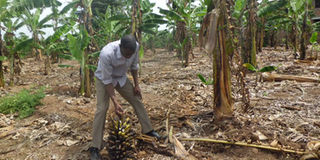Progress made in fight against banana bacterial wilt but ...

Bulugu, a farmer in Lwengo District, shows a banana bunch and plantation that has been affected by the banana bacterial wilt. PHOTO BY LOMINDA AFEDRARU
Banana is grown in nearly 130 countries around the world. In Sub-Saharan Africa, Uganda is the biggest banana producer followed by Rwanda, Ghana, Nigeria and Cameroon. However, the crop could be wiped out by a disease that is spreading across different countries in Africa.
Banana Xanthomonas Wilt (BXW), or Banana Bacterial Wilt (BBW), was first reported in Uganda in 2001. This was after farmers in Mukono and Kayunga District reported a “strange disease” affecting their plantations, but the scientists discovered it was BBW. It is now prevalent in many banana growing regions of Kenya, Tanzania, Rwanda, Burundi and DR Congo.
The disease is spread by flies that visit the flowers of the male bud as well as farm tools such as pangas that are used to cut infected crops.
Farmers in central and western parts of the country have been the hardest hit. But there have been interventions to enable them control spread of the disease.
In a report by National Agricultural Research Laboratories (NARL) Kawanda, it is stated that since the disease was discovered, the farmers have used several cultural control methods without much success.
The scientists embarked on getting a solution and this led to the Banana Bacterial Wilt project. This involved developing BBW-resistant varieties, namely sweet banana, East African highland banana (commonly known as matooke).
The project is a public-private partnership involving African Agricultural Technology Foundation (AATF), International Institute of Tropical Agriculture (IITA) and Naro. AATF solicits royalty-free genes that are incorporated into banana using biotechnology.
Learn from others
In 2004, IITA and Naro scientists started the process of developing transgenic (containing genetic material from another plant) BBW-resistant bananas in a joint project funded by Gatsby Charitable Foundation. AATF joined the project in 2005, and successfully negotiated for two genes—plfp and hrap from Academia Sinica.
The researchers had heard that scientists at IITA in Taiwan had extracted a gene from green pepper in their research on rice and sweet potatoes for bacterial wilt resistance.
In 2007, they got permission from National Bio-safety Committee to import this gene after Naro acquired a sub-license from IITA for the same.
The team introduced the green pepper gene into local banana varieties in the laboratory and field trials. And eight lines have been selected, which showed 100 per cent resistance to BBW.
Dr Andrew Kiggundu, head of the Biosciences department, NARL, explains that the trials started with 60 lines. Further selections will be done during different field trials and they may end up with two to three lines.
However, the option of providing farmers with these transgenic varieties can only occur if the biotechnology and biosafety law is in place.
His advice to farmers is that they should learn from others who have succeeded in controlling BBW. If they opt for tissue culture plantlets, the planting should be done on land with no history of BBW or land, which has been fallow for a long time.
The procedure is that after the variety tested has good results, there is need to carry out tests in different locations to see how the crop copes up with different topography in the country.
NARL is seeking permission from Uganda National Council of Science and Technology for multi locational trials in Mbarara, Mbale and Luweero districts.
Farmer’s experience
“My name is Michael Bulugu, the farm manager of Ziga Farm, in Manja A village in Lwengo District. It belongs to the family of the late Joseph Semukungu. We specialise on growing matooke on three acres mainly for export to UK, where my uncle Paschal Sekasamba manages our family vegetable grocery in London.
The plantation has been well managed and we have been getting good harvest. But two years ago, the plantation was hit by banana bacterial wilt.
We tried all the sanitary measures—cutting off the infected suckers and burning them as well as removing flowers from the male bud but the plantation is almost getting wiped out.
We tried applying manure but still we have the disease burden. So, we have given up. The whole neighbourhood is experiencing this problem and other farmers are now shifting to growing other crops such as maize and cassava
Previously, we used to harvest 150 bunches of matooke but now we only get 10 bunches in a month.
The family is now concentrating on coffee and maize as well as keeping poultry. We are no longer exporting what is harvested from our farm but we purchase from other farmers in the village for export but we cannot reap better proceeds due to the market price offered by the farmers.”




